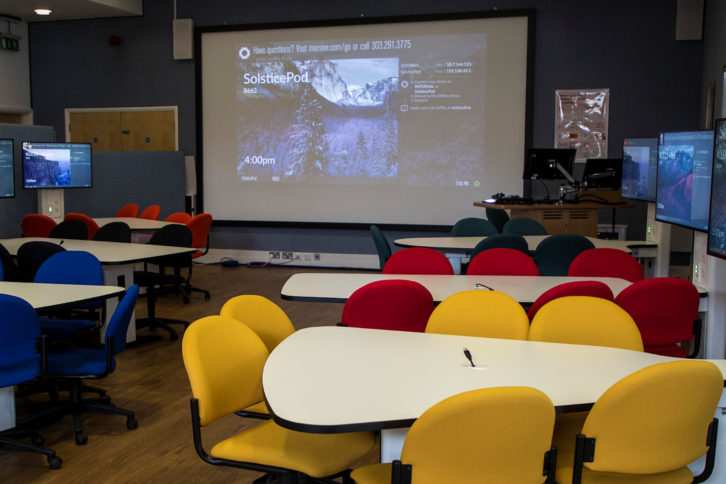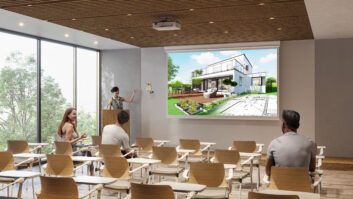
In the first part of this feature we considered whether the current education technology framework is helping primary and secondary schools thrive or survive. Here David Davies looks at what technology is in higher demand and how investments are divided between new installs and upgrades.
Despite the financial context in which many schools currently operate, many contributors report good levels of business from both upgrades and brand-new installs.
Ben Spurgeon is senior application engineer at AV equipment provider Audiologic. “Installation projects include many of both new and upgraded systems,” he says. “Rooms of lower and lower occupancy are requiring an AV system, while larger spaces are requiring larger and more complicated solutions to deliver the required content. We are seeing an increasing demand for surround sound within lecture theatres, which takes systems to a more immersive level. As the audio playback systems develop, we are also seeing requirements for dedicated speech reinforcement systems to accompany the upgraded content solution.”
John Dykes, business development director at Casio, observes that “while conventional classrooms are mostly upgrading, new installs are flourishing for new room types. This includes meeting spaces, collaboration spaces for group work, and breakout areas designed to encourage group discussion. In terms of procurement, this translates to ultra-short throw projectors designed for smaller spaces, interactive flat panel displays, and technology which is easy to connect and share with.”
“Rooms of lower and lower occupancy are requiring an AV system, while larger spaces are requiring larger and more complicated solutions”
Ben Spurgeon, Audiologic
Peter Curtis, business development manager at POLAR, is among many who believes that education investments tend to be split “fairly evenly between new installs and upgrades”. In terms of whether those in the education sector now have a deeper understanding of new technologies, the answer is a resounding ‘yes’. “Educational technologists, AV managers and IT departments are more informed about products and services offered by manufacturers,” he says. “They have an extensive knowledge of networking and how the products they employ need to satisfy their customer base. Extensive training needs to be offered, and product demonstrations have to be more sophisticated as they are involving more than just the AV manager. Questions they tend to ask involve networking and cloud usage as well as functionality.”
Education customers “certainly know what they want in terms of features and demands for great value, as well as the freedom to teach the way they want,” says Chris Goff, head of product management at BenQ, who cites an example of how BenQ has responded to a specific teaching requirement: “We made a conscious decision to make our software-agnostic, which has allowed schools to use Google, specialist apps or their own established ecosystem, while also benefiting from bringing new teaching and learning technologies into the school environment.”
As the baseline level of knowledge among education professionals rises, it follows that AV companies must ensure they are always one step ahead of the latest developments in communicating to potential clients. For example, says Spurgeon, “we like to ensure that we can provide an extensive range of documents to help support our proposals, such as acoustic maps and schematics, further detailing the performance of the systems we have put forward. Developments in software allow us to keep expanding upon this, with more accurate acoustic simulations being possible with current iterations of software.”
Emerging requirements
At the risk of making a crude summary, one main expectation is for ‘more of the same, only more so’ in terms of schools’ AV requirements over the next few years. So collaborative tools and improved display and audio solutions are likely to feature prominently, along with one or two newer technologies such as voice control.
As well as its ability to make day-to-day learning more flexible, Toni Moss is managing director of CDEC, highlights AV over IP’s ability to “facilitate distance learning, lecture capture, create breakout spaces, live-stream events, and allow the help-desk a live view of what is on-screen during a lecture, facilitating support. Meanwhile, voice control is also on the horizon and we can enable this on control interfaces via Amazon Alexa. Room users instruct the Alexa to power on the AV, select an input source, control the volume, and switch off at the end of the session.”
Effective operation and management of the core network infrastructure will only become more critical, and with the number and range of online threats continuing to grow schools will be obliged to devote more time and resources to security. “Use of products on the IT network and cloud usage – whether it’s switching, sharing information across multiple classrooms over a campus, or distance learning – are only going to become more prevalent,” says Curtis. “Security is a must, and if cloud usage is a factor with these products [customers will want to be assured that they are accompanied by] the highest security measures available.”
But as much as the classrooms of the future will be shaped by the development of new technology, they will also be informed by an evolving curriculum and different teaching practices. So as well as remarking that “BYOD will continue to grow”, Dykes suggests that “in the schools the focus is going to be all about technology which supports the curriculum effectively. The curriculum is already shifting towards one which focuses on cultivating soft skills such as leadership, teamwork and problem-solving. As an industry we need to produce technology which supports the development of these skills.”
Encouragingly, there is every indication that vendors and integrators are managing to satisfy both current educational needs and help schools look forward confidently with solutions that will accommodate the probable classroom requirements of the future.
‘An alarming disparity’
Aidan Crowe, group sales manager of Pure AV, highlights a concerning discrepancy in the education market when it comes to new technologies…
“There are still schools and colleges being built and generating demand for new installations, but the more significant part of the activity within compulsory education is centred around the upgrade and replacement of legacy equipment. Many schools have not upgraded their classroom display technology in the last five years or have done so on an ad-hoc basis, as hardware has failed.
“The result is an alarming disparity between the equipment available to teachers within the same school environment, with different display equipment used in different classrooms. Within the university space, there is a significant focus on the provision of a standard teaching environment across the estate; many schools would love to be able to replicate this level of consistency across the classrooms within their own building.”
www.audiologic.uk
www.benq.com
www.casio-projectors.eu
www.cdec.co.uk
www.polar.uk.com
www.pureav.co.uk







